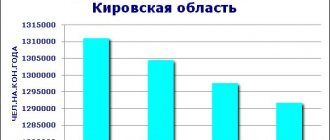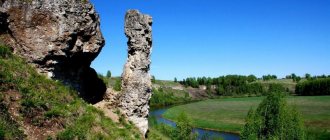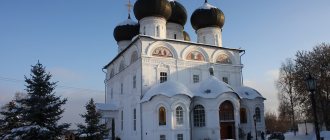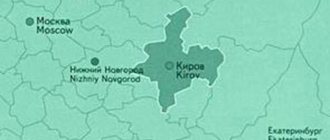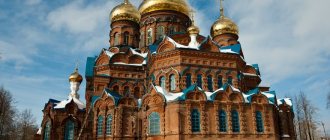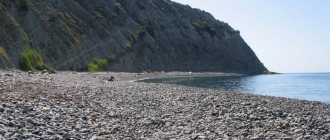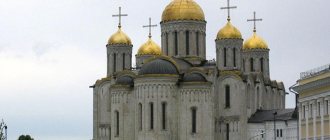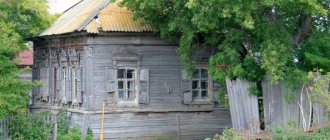Vyatskiye Polyany
(Kirov region)
OKATO code:
33404
Founded:
1596
Urban settlement since:
1938
City since:
1942 City of regional subordination
Center:
Vyatskopolyansky district
Telephone code (reference phone)
| 83334***** | 22-2-22 |
Deviation from Moscow time, hours:
0
Geographic latitude:
56°13′
Geographic longitude:
51°04′
Altitude above sea level, meters:
100 Sunrise and sunset times in the city of Vyatskie Polyany
Map
| Vyatskie Polyany: maps |
Vyatskie Polyany: photo from space (Google Maps) Vyatskie Polyany: photo from space (Microsoft Virtual Earth)
| Vyatskiye Polyany. Nearest cities. Distances in km. on the map (in brackets along roads) + direction. Using the hyperlink in the distance , you can get the route (information courtesy of the AutoTransInfo website) | |||
| 1 | Krasnaya Polyana | 4 (7) | NE |
| 2 | Kukmor | 10 (13) | Z |
| 3 | Sosnovka | 13 (15) | IN |
| 4 | Kizner (Udmurt Republic) | 28 (275) | IN |
| 5 | Malmyzh | 41 (57) | NW |
| 6 | Shemordan (Republic of Tatarstan) | 42 (114) | Z |
| 7 | Bogatye Saby (Republic of Tatarstan) | 44 (135) | SW |
| 8 | Baltasi (Republic of Tatarstan) | 55 (134) | Z |
| 9 | Grakhovo (Udmurt Republic) | 58 (232) | IN |
| 10 | Mamadysh | 61 (73) | YU |
| 11 | Tyulyachi (Republic of Tatarstan) | 63 (150) | SW |
| 12 | Arsk | 75 (126) | Z |
| 13 | Mozhga | 75 (230) | IN |
| 14 | Elabuga | 78 (132) | SE |
| 15 | Nizhnekamsk | 79 (197) | SE |
| 16 | Kilmez | 80 (114) | WITH |
| 17 | Vavozh (Udmurt Republic) | 80 (256) | NE |
| 18 | Mendeleevsk | 85 (154) | SE |
| 19 | Alnashi (Udmurt Republic) | 87 (192) | IN |
| 20 | Kamskie Polyany (Republic of Tatarstan) | 89 (244) | YU |
| 21 | Naberezhnye Chelny | 97 (153) | SE |
| 22 | Chistopol | 98 (250) | YU |
| 23 | Bolshaya Atnya (Republic of Tatarstan) | 99 (162) | Z |
| 24 | Rybnaya Sloboda (Republic of Tatarstan) | 102 (174) | SW |
| 25 | Pestretsy (Republic of Tatarstan) | 102 (195) | SW |
| 26 | Syumsi (Udmurt Republic) | 104 (155) | WITH |
| 27 | Uva (Udmurt Republic) | 109 (224) | NE |
| 28 | Mari-Turek (Republic of Mari El) | 109 (369) | NW |
| 29 | railway station High Mountain (Republic of Tatarstan) | 113 () | Z |
| 30 | High Mountain (Republic of Tatarstan) | 114 (167) | Z |
a brief description of
The city is located in the Urals, on the high right bank of the river. Vyatka, in its lower reaches (pier), 350 km southeast of Kirov.
Railway station on the Kazan - Agryz line.
Territory (sq. km): 28
Information about the city of Vyatskie Polyany on the Russian Wikipedia site
Historical sketch
Until the middle of the 16th century. on the site of Vyatskie Polyany there was a small Udmurt village of Oshtorma-Bodnya. After the victory of the Russian state over the Kazan Khanate in 1552, the development of the Vyatka region by Russians began.
Founded in 1596 as the patrimony of the Vyatka Assumption Monastery - the Nativity Monastery (existed until 1764). The village of Vyatskaya Polyana grew around it, becoming a village in the 17th century. a busy center for trade in grain and timber. Of the trades, woodworking and brick production were the most developed.
The name of the glade means “an open meadow tract in the middle of a forest or at its edge,” and the definition indicated its location on the river. Vyatka.
From the middle of the 19th century. The importance of Vyatskiye Polyany as a river pier increased. The pier and a significant part of the shipping company were in the hands of the owner T.F. Bulychev and his company.
The railway was laid in 1915. Moscow - Yekaterinburg, which has noticeably revived transport and trade relations with the industrial centers of the Volga region and the Urals.
At the end of the 19th - beginning of the 20th centuries. the name takes the form Vyatskie Polyany. In 1938, the village was transformed into a workers' settlement. City since 1942
Municipal indicators
| Index | 2001 |
| Demography | |
| Number of births, per 1000 population | 7.3 |
| Number of deaths, per 1000 population | 13.9 |
| Natural increase (decrease), per 1000 population | -6.6 |
| Standard of living of the population and social sphere | |
| Average monthly nominal accrued wages, rub. | 1828 |
| Average housing area per inhabitant (at the end of the year), sq.m. | 18.1 |
| Number of preschool institutions, pcs. | 10 |
| Number of children in preschool institutions, thousand people | 1.6 |
| Number of daytime educational institutions (at the beginning of the school year), pcs. | 7 |
| Number of students in daytime educational institutions, thousand people | 5.6 |
| Number of doctors, people. | 161 |
| Number of nursing staff, people. | 494 |
| Number of hospital institutions, pcs. | 3 |
| Number of hospital beds, thousand units | 0.7 |
| Number of medical outpatient clinics, pcs. | 5 |
| Capacity of medical outpatient clinics, visits per shift, thousand units. | 1.4 |
| Number of registered crimes, pcs. | 456 |
| Economy, industry | |
| Number of enterprises and organizations (at the end of the year), pcs. | 526 |
| Construction | |
| Volume of work performed by type of activity “Construction” (until 2004 - volume of work performed under construction contracts), million rubles. | 15.8 |
| Commissioning of residential buildings, thousand sq.m. of total area | 9.3 |
| Commissioning of residential buildings, apartments | 0 |
| Commissioning of preschool institutions, places | 0 |
| Commissioning of educational institutions, places | 0 |
| Commissioning of hospital facilities, beds | 0 |
| Commissioning of outpatient clinics, visits per shift | 0 |
| Transport | |
| Number of bus routes (in intracity traffic), pcs. | 3 |
| Number of passengers transported by buses per year (in intracity traffic), million people. | 5.4 |
| Trade and services to the population | |
| Retail trade turnover (in actual prices), million rubles. | 396.2 |
| Retail trade turnover (in actual prices), per capita, rub. | 9478 |
| Public catering turnover (in actual prices), million rubles. | 20.3 |
| Volume of paid services to the population (in actual prices), million rubles. | 123.5 |
| Volume of paid services to the population (in actual prices), per capita, rub. | 2954.9 |
| Volume of household services to the population (in actual prices), million rubles. | 19.7 |
| Volume of household services to the population (in actual prices), per capita, rub. | 471.7 |
| Investments | |
| Investments in fixed assets (in actual prices), million rubles. | 69.1 |
| Share of investments in fixed assets financed from budgetary funds in the total volume of investments, % | 2.5 |
Data sources:
- Regions of Russia. Main characteristics of the constituent entities of the Russian Federation: statistical collection. Goskomstat of Russia. - M:, 2003.
Economy
Mechanical engineering (production of sidecars for motorcycles, trailers, etc.). Brick factory, meat processing plant, butter factory, bakery, oil cooler, poultry factory, etc.
In the Vyatskopolyansky region, wheat, rye, barley, oats, cabbage, beets, onions, carrots, and potatoes are grown. Cattle are raised. Pig farming.
Deposits of limestone, gravel, building stone, sand, clay, peat, etc.
Main enterprises
MECHANICAL ENGINEERING AND METAL WORKING
OJSC "Vyatskopolyansky House Builder"
612910, Kirov region, Vyatskopolyansky district, Krasnaya Polyana village, st.
Druzhby, 1 Offers:
Container-type houses, furniture, fiberboard
MEAT INDUSTRY
JSC "Strateg"
612900, Kirov region, Vyatskie Polyany, st.
Depovskaya, 2 Offers:
Meat, sausages
Culture, science, education
Historical Museum.
House-museum of automatic weapons designer G.S. Shpagina.
Universities of the city
Vyatka State Humanitarian University (branch in Vyatskie Polyany)
612961, Kirov region, Vyatskie Polyany, st. Sovetskaya, 13 WWW: https://filial-vggu.narod.ru/
Vyatskopolyansky branch of Kazan State Technical University named after. A.N. Tupolev
612960, Kirov region, Vyatskie Polyany, st. Lenina, 244-246
Museums, galleries, exhibition halls
Vyatskopolyansky Historical Museum 612960, Kirov region, Vyatskie Polyany, st. Sovetskaya, 51 Phone(s): (83334) 6-24-80 Website: https://vp-museum.rf/
Architecture, sights
Nicholas Church (1826).
17 km from Vyatskie Polyany, in the village of Sushi, there is a wooden Archangel Church (1733).
| Population by year (thousands of inhabitants) | |||||||
| 1939 | 10.6 | 1996 | 42.6 | 2007 | 39.0 | 2015 | 33.3 |
| 1959 | 25.7 | 1998 | 42.3 | 2008 | 38.8 | 2016 | 33.1 |
| 1967 | 31 | 2000 | 42.2 | 2010 | 38.3 | 2017 | 32.8 |
| 1970 | 32.7 | 2001 | 42.0 | 2011 | 35.2 | 2018 | 32.6 |
| 1979 | 37.6 | 2003 | 40.2 | 2012 | 34.5 | 2019 | 32.1 |
| 1989 | 44.5 | 2005 | 39.7 | 2013 | 34.0 | 2020 | 31.9 |
| 1992 | 46.0 | 2006 | 39.4 | 2014 | 33.6 | 2021 | 31.5 |
Team Nomads
Vyatskie Polyany is a city (since 1942) in the Kirov region, Russia, located on the right bank of the Vyatka River. The fourth largest city in the Kirov region, it forms an independent municipal entity “City of Vyatskie Polyany” within the Kirov region. Administrative center of the Vyatskopolyansky district. Population - 34,965 inhabitants (2013). Until the middle of the 16th century, the territory of the lower reaches of the Vyatka River, part of the so-called Arsk region, was inhabited by Mari, Tatars and Udmurts and subordinated to the Kazan Tatar Khanate. According to legend, on the site of modern Vyatskiye Polyany there was a small Udmurt settlement of Oshtorma-Bodya.
MONUMENTS OF ARCHEOLOGY OF THE KIROV REGION - HERE!
ATTRACTIONS OF THE KIROV REGION - HERE!
ARTICLES AND LINKS ABOUT THE KIROV REGION - HERE!
TREASURES OF THE KIROV REGION - HERE!
NATURAL MONUMENTS OF THE KIROV REGION - HERE!
GEOGRAPHY OF THE KIROV REGION - HERE!
ice drift on the Vyatka River Vyatskie Polyany
Military actions associated with Moscow's conquest of the Kazan Khanate forced the Udmurt population to leave their homes. The fields and meadows of the Oshtorma-Bodya settlement were gradually overgrown with forest and bushes. These overgrown “clearings” began to be called Vyatskie Polyany.
An old legend says that at the end of the 16th century, the Monk Tryphon the Wonderworker of Vyatka, the founder of the Vyatka Assumption Monastery, having taken a fancy to the picturesque lower reaches of Vyatka, ordered the monks to settle in the still uninhabited “Vyatka clearings”, lost among the ship pines, blue lakes and small rivers. He decides to build a monastery here to strengthen his position and to more successfully spread Orthodoxy among the local population.
The first mention of Vyatskie Polyany dates back to 1595, when Tsar Fyodor Ioannovich (son of the Terrible) issued a royal charter to the monks for possession of wastelands - glades. With the blessing of St. Tryphon, initially 12 (in some sources - 15) monks moved to the right bank of the Vyatka. The monastery is being built here quickly, and on its territory the first church is being built to serve the monastic brethren, which recruits “40 brothers, 5 priests, a deacon, and 30 monastic workers.” The monastery peasants of the Voblovitsky volost of the Slobodsky district were forcibly sent to the lower reaches of Vyatka to settle new lands. In 1599, a monastery with a temple was built and upon consecration received the name Nativity of Christ. The name of the monastery was often used to call the settlement that arose next to it - the village of Rozhdestvenskoye (Rozhestvennoye), along with the old name of the town - Polyanka. Next, Tryphon blessed the construction of a second temple on the site where St. Nicholas Cathedral now stands, for people - the laity. The second church was built in 1615 in wood and consecrated in honor of the saint and wonderworker Nicholas, Archbishop of Myra.
Thus, the Monk Tryphon visited these places twice: during his trip to the Kazan governor with the tsar’s decree and at the laying of the first stone for the foundation of the St. Nicholas Church.
Vyatskiye Polyany
In addition to the monastic peasants, palace (state) peasants also began to settle on these lands. In 1607, a palace village appeared near Polyany. In the vicinity of Vyatskie Polyany the village arose. Usad is the patrimony of the Kazan Metropolitan. Migrants settled here without permission, both Russians and foreigners, who wanted to get rid of all state duties. Therefore, the first century of the existence of the Nativity Monastery was often accompanied by territorial disputes. Thus, the Nativity of Christ Monastery was a kind of branch of the Khlynovsky Assumption Monastery. In 1764, by a manifesto of Empress Catherine II, all church estates were transferred from the ecclesiastical department to the department of the College of Economy. Since then, the monastic peasants began to be called economic. After the secularization of church and monastic lands (their alienation in favor of the state), the Nativity Monastery in Vyatskie Polyany was closed.
Michael the Archangel Church Vyatskie Polyany
We suggest starting your acquaintance with the sights of the city at the Archangel Michael Church, a wooden pearl of the Vyatka region, carefully transported to Vyatskie Polyany from the village of Sushi. It is assumed that the monks of the Trifonov Monastery were initially sheltered in the Sushinskaya monastery estate, located on the left bank. Here, next to a church built by talented ancient Russian craftsmen, they served their prayer services, preparing to move to a new place. Time has not been kind to the masterpiece created by ancient masters. The wooden church has experienced many shocks. During the years of Soviet power, there was a village club and a granary here, and then the temple was completely abandoned to the mercy of fate. In 1960, it was taken under state protection as a historical and cultural monument. However, even after this, little funds were allocated for repairs and maintenance, and the ancient rural temple gradually fell into disrepair. Meanwhile, the village of Sushi fell into decay over time, only frail old people remained here.
In May 1998, in order to preserve the unique monument of ancient Russian architecture, it was decided to move the church to Vyatskie Polyany. When they carefully dismantled it, on the last crown they found a mortgage log, on which the date was cut down - 15... The last two digits, time, unfortunately, did not spare. If this was the date of the founding of the temple, then, undoubtedly, it could have existed much earlier than Vyatskiye Polyany. The ancient temple was carefully moved and restored on the outskirts of the city, next to the ancient cemetery where the Vyatka hero and Knight of St. George V.F. is buried. Babushkin. Near the memorial complex where fellow countrymen - participants of the Great Patriotic War - are buried. Inside the temple there is a memorial plaque on which the names of fellow countrymen who died in the line of international duty in the hot spots of the planet, as well as the liquidators of the Chernobyl accident, are engraved in gold. The restoration of the lower church was completed on the eve of the Nativity of Christ in 2002. Cells of a monastery are being built at the church, the organization of which received the blessing of the Archbishop of Vyatka and Slobodsk (now Metropolitan) Chrysanthus. A wooden gate church topped with a bell tower rose above the entrance to the monastery territory. This church is dedicated to St. Onuphrius the Great and will be intended for the monastic brethren. Every day the bells of the monastery chime with the belfry of St. Nicholas Cathedral, because they are located almost next to each other, in direct visibility. At this time, the gaze involuntarily rushes to the high blue sky, in the vastness of which wooden beauty seems to float, cut down by ancient and modern craftsmen in the name of saving our souls. Next to the pearl of ancient Russian architecture are the picturesque Vyatka ridges, and a talkative river flows in the spring. Nearby is a spring with a chapel, the life-giving water of which is blessed annually
Volost government If you walk along Sovetskaya Street from the Archangel Michael Church, then the border of the historical part of the village of Vyatskie Polyany (before the time when the village became a city) begins from the former building of the volost administration, which until 1917 housed: the zemstvo chief, the volost foreman, bailiff, justice of the peace, lawyer, clerk, forester and other officials. The village of Vyatskie Polyany became a volost center at the beginning of the twentieth century. On February 17, 1918, in this building, in the presence of several Bolsheviks and sympathizers, the establishment of Soviet power in the village and volost was announced. During the Great Patriotic War and in the post-war period, classes of Vyatskopolyanskaya secondary school No. 1 were located on the second floor of the building.
view of the Vyatka River Vyatskie Polyany
“House of Sobriety” At the beginning of the twentieth century, an experiment was conducted in Vyatka: under pressure from temperance societies, it was forbidden to sell vodka to take away. It was believed that the “cultural atmosphere” of drinking establishments would wean bitter drunkards from their favorite drink. However, they did not drink less. The house of the temperance society in Vyatskie Polyany was located in Bolshoy Lane (Sovetskaya St., 41) opposite the zemstvo government. Mostly only wealthy people visited it. Peasants were denied access to this house, as large annual contributions were required. In fact, this is the first cultural and educational institution in the village where one could spend one’s leisure time. In the “House of Sobriety,” visitors had billiards and a card table, and a string orchestra played. Here, in 1915, film shows began to be shown for wealthy village residents. Films were brought from Kazan. The room where the film was shown could accommodate no more than 50 spectators. During the Civil War, the premises of the Temperance House were used to hold meetings of Red Army soldiers. After 1919, the People's House was opened in Vyatskie Polyany in the former house of Sannikov, where leisure activities were organized for all residents of the village.
Vyatka River, Vyatskie Polyany
Police station On the site of this corner house before the revolution there was a police station, the number of officials in which reached up to 25 people: many political exiles lived in Vyatskiye Polyany. The house was two-story, on the lower floor there was a “punch” for temporary detention, and in the courtyard there were stalls for horses. Here, in 1929, residents of the village of Vyatskie Polyany first heard radio broadcasts from Moscow. The first radio amateurs, telegraph operators of the regional communications center Vasily Filippovich Solovyov and Viktor Rylov installed a small tube radio receiver and one loudspeaker for collective radio listening. In 1930, the building was demolished (no photographs found) and a school was built in its place. Then a kindergarten settled here. Currently it is a residential building.
Vyatskiye Polyany
The stage premises The village of Vyatskie Polyany was located on the ancient Siberian highway, along which mail was transported and prisoners were transported into exile and hard labor. The Decembrists marched along the Siberian Highway, shackles jingling. The padlocked shackles were very heavy. How did the poor fellows measure hundreds of miles along the ground with them? They said that before crossing the Vyatka they had to be worn. But where there were no crossings or forests, they were removed to speed up the movement. The prisoners were left with only hand shackles, the chains of which were thinner. It is known that the Russian revolutionary democrat A.N. passed through the Malmyzh district to Siberian exile. Radishchev. In his diary, he wrote aptly and succinctly: “The residents are poor, the huts are thin.” In the house built by the zemstvo government next to the police station, there was a staging room. There were two prison cells, a room for the convoy and a room for the family, who looked after the premises, cleaned and heated its rooms. All the windows of the stage house had iron bars. The prisoners were transferred here for overnight stays on Tuesdays and Thursdays from Malmyzh. And from Vyatskiye Polyany those transported were sent to Nizhniye Shuni.
Vyatskiye Polyany
Zemstvo School A two-class zemstvo school of the second level, it was built in 1901 at the expense of the merchant M.A. Zaitsev and was donated to the zemstvo in exchange for the first wooden parish school, the building of which had fallen into disrepair. After the revolution, there was a tractor-mechanical technical school here until 1935. Then a seven-year school was located in the building. The future Hero of the Soviet Union A.P. studied there. Kukin (this is evidenced by a memorial plaque; the school has a stand with photographs and letters of the hero) and Hero of Russia V.M. Gorbunov. After the opening of Vyatskopolyanskaya secondary school No. 1, only classes of primary school No. 1 remained here. Since 2000, children of a special (correctional) school of type 8 have been studying in the building.
Pozharny Lane At the fire tower in Pozharny Lane there was an open-air platform for peasant village gatherings. It is curious that in the firehouse there was kept a pair of leather boots and a good shirt, in which poor peasants got married. In Pozharny Lane lived a merchant Nikolai Fedorovich Goloviznin (born in 1878), who had his own store on Bolshaya Street (Lenin Street), where they sold salted and fresh fish. Behind his house (see photo) there was a glacier where the catch brought by the village fishermen was stored. Most of the fresh fish came from Staraya Beloguzka. During the years of Soviet power, the warehouses where the glacier was located were used as stables, and in the 80s there was a sobering station in them.
House of timber merchant Sannikov This house belonged to a large timber merchant from the village of Kulygi, Alexey Ivanovich Sannikov. The Soviet government in the village of Vyatskie Polyany nationalized shops, warehouses, residential buildings and other property of merchants and timber merchants. (Sannikov's house)
In 1919, in the former house of Sannikov, the People's House named after K. Liebknecht and R. Luxemburg was opened, which was a club where amateur artists performed. In 1930-1931, the People's House was transferred to the former building of St. Nicholas Church. And in the vacated house the district committees of the All-Union Communist Party (Bolsheviks) and the Komsomol are located. The editorial office of the regional newspaper “Vyatsko-Polyanskaya Pravda” worked here for some time. In the 50s, the House of Pioneers began to operate in the building.
checkpoint
Valitov's manufacturing store The first floor of this building at the beginning of the last century was the manufacturing store of the Tatar merchant Valitov. Behind was the bailiff's office. When the first issue of the regional newspaper “Vyatsko-Polyanskaya Pravda” was published, that is, on September 18, 1930, the circulation was printed in the Kukmor printing house, since there was no one of its own yet. The printing house in Vyatskie Polyany, located in a former store, began with an old-style flat-bed printing machine, which often broke down, and then the laid-out pages had to be transported again by horse to Kukmor, and if there was a lack of white paper, newspapers were produced on gray wrapping paper. In 1975-1979 A new two-story building was added to the printing house, and the second floor above the old premises was rebuilt. On the ground floor there is a printing house, on the second floor - in approximately the same area - the newspaper editorial office.
House of the merchant Bashkirov The denture and x-ray departments of the central district hospital operated in the building. In 1952, the first X-ray machine of the Burevestnik type in Vyatskie Polyany was installed here. Until this time, there was an X-ray machine only in the village of Kukmor.
House of merchant M.A. Zaitsev The house in which until 1918 the family of the timber merchant, merchant of the first guild M.A. lived. Zaitseva. During the Civil War in 1919, the Revolutionary Military Council of the 2nd Army of the Eastern Front was located here. Later, the Vyatskopolyansky district executive committee worked here until 1980. Currently, the building is occupied by the district military registration and enlistment office.
House of merchant V.F. Koshcheeva The building was built in 1910. Until 1918, the family of the merchant of the first guild V.F. lived in this house. Koscheeva. During the Civil War from August 1918 to July 1919. The field headquarters of the 2nd Army of the Eastern Front was stationed here (a memorial plaque on the house indicates this). Later, the police stationed here until 1964. Currently it is a residential building.
Trading warehouses The warehouses belonged to the merchant V.F. Koscheev. During the Soviet period, there were warehouses and city trade stores here. Currently, after reconstruction, a branch of the Vyatka State Humanitarian University (branch of VyatGSU) operates in the building.
Houses of the Falaleev brothers The houses were the property of the brothers Konstantin, Alexander, Vasily and Nikolai Falaleev, who ran a yamshchina. They had at least a dozen riding horses. The crews had excellent harnesses, with bells on the harnesses and bells on the bow. The brothers carried passengers and mail up the Vyatka to Malmyzh and Urzhum, and in the lower reaches to Naberezhnye Chelny, Yelabuga and Mamadysh. After October 1917, various institutions were located here: a furniture workshop; in 1968, the ambulance service was transferred here (in a building in the courtyard); The methodological office of the Central Regional Hospital, the office of the chairman of the Republic of Kazakhstan trade union of healthcare workers, and later the accounting department of the sanitary and epidemiological station were also located here. In addition to the ambulance, there were apartments for nine families.
Shaposhnikova's workshop In this stone corner house, which belonged to artisan trader Evgenia Shaposhnikova, there was a workshop for the sale and repair of men's and women's hats. There was a district prosecutor's office here for a long time. Later - a road section. Now there are warehouses. In the neighboring one-story stone house on the right (formerly Falaleev’s house), in the 30s and 40s there was a cooperative artel “Red Handicraftsman” (later artel “Trud”), in which they sewed clothes and repaired shoes, musical instruments, and worked as a photographer.
St. Nicholas Cathedral
The fate of the church consecrated in honor of St. was difficult and ambiguous. Nicholas the Wonderworker. After its closure, in 1948, a prayer house was built in the village. Usad, not far from the city. It was in effect until January 11, 1961. Since then, believers have been forced to travel 60 km to the Epiphany Cathedral in Malmyzh. However, spiritual traditions in Vyatskie Polyany were preserved. Parishioners organized two “underground” prayer houses, which operated in different parts of the city. During the years of perestroika, believers submitted an application to the authorities with a request to register the community of the Russian Orthodox Church. The church building was handed over to the Orthodox community on December 25, 1987. Literally 2-3 days later, the first service took place right on the street near the church. And on January 12, the first service was held in the building itself. The solemn service, with a large crowd of people, took place exactly a week later, on the Epiphany of the Lord. Long and painstaking work began to restore the shrine. Many townspeople selflessly participated in the restoration work. On some days, 300-400 people participated. St. Nicholas Church was the first in the Kirov region to purchase bells in Voronezh. For these purposes, parishioners donated 20 thousand rubles. The very first and largest bell, weighing 30 poods, spoke for the first time from the restored bell tower of St. Nicholas Church on August 2, 1989.
On January 20, 1988, the St. Nicholas Church, recreated in its original form, was given the status of a cathedral by decree of Archbishop (now Metropolitan) of Vyatka and Slobodsk Chrysanthus.
Tokarev House The house of a major timber entrepreneur, owner of two mills, Alexei Nikitich Tokarev (born in 1877, from the village of Kinyaus). The building was built in the period 1914-1917. During the Civil War in 1918-1919. the political department and commandant's office of the 2nd Army of the Eastern Front were located here. There was a printing house in the house where the army newspaper was printed. Andrei Pavlovich Kuchkin was appointed political commissar and member of the RVS of the 2nd Army from September 1918. Subsequently, the building served as a regional communications center. There was also a telephone exchange here (later it was attached to the radio center on the corner of Uritsky and Lenin streets - now there is a monument to the heroes of the front and rear in this place). Behind the house of the communications center there was a stable where post horses were kept. Currently, the 1st post office is located here.
Krasnoarmeyskaya Street The Kukin family lived in this house on Krasnoarmeyskaya Street, stretching along Povarenny Log. The owner of the family, Pyotr Fedorovich, was a well-known saddler in the area who made horse harnesses. The family was large - 10 children. The sixth child was the future Hero of the Soviet Union Arkady Petrovich Kukin (born in 1914). In 1944, housewife Anna Petrovna Kukina was nominated for the title of “Mother Heroine”.
House-museum of weapons designer G.S. Shpagina
In this modest house on the very bank of the Vyatka River, the famous small arms designer, Hero of Socialist Labor G.S. lived with his family from 1941 to 1952. Shpagin. Now the house has been renovated, a lot of effort has been made to put it in order without changing its previous appearance. A lot of things that belonged to the Shpagins were collected; many of the museum exhibits were donated by relatives of the famous designer. This is a buffet, table, chairs, dressing table, wardrobe. Georgy Semenovich's personal belongings - a leather coat, a desk, books that he used, which he loved to read and re-read, which he thought about. Three small modest rooms - a hall, a maid's room, my father's office - and then his bedroom. Everything is very simple and modest. The house-museum was inaugurated on August 7, 1982.
Population, people 1959 1970 1979 1989 2002 2013 25,717 32,729 37,624 44,513 40,282 38,260
Sights St. Nicholas Cathedral (1596). Historical Museum. Nativity Monastery. Convent. House-museum of automatic weapons designer G. S. Shpagin. Monument to the heroes of the Great Patriotic War on Victory Square in the city park. Labor Square with fountains.
holy spring at the Archangel Michael Church
Cultural and leisure, in which national creative groups work: the Mari song ensemble “Peledysh”, the Tatar song ensemble “Koyash”, the Udmurt ensemble of song traditions “Chipchirgan”, the folk group “Rozhdestvenskoe Selo”, the bard song ensemble “White Bird”, the ensemble author's song "Golden String" and vocal group "Small Town". Natalya Vladimirovna Sobakinskikh is the head of the center.
Folk Culture Center "Rus"
Television KGTRK "Vyatka" with inclusions of MUP "TRK "Vyatskie Polyany" Local cable television - Molot LLC "Cable Television Center"
Radio Autoradio Vyatskie Polyany FM 103.4 Europe Plus Vyatskie Polyany - FM 106.7 Road radio Vyatskie Polyany 105.4 Radio "Maria FM" - Vyatskie Polyany FM 107.1
Victory Park
Newspapers 7 evenings Vyatsko-Polyanskaya Pravda First-hand Mood Fatherland Working Tribune About the glades. RU
Industry City-forming enterprise: Vyatsko-Polyansky Machine-Building Plant (VPMZ), now OJSC "Molot" - a former bobbin-reel factory, transformed during the Great Patriotic War after the evacuation of designer Georgy Semenovich Shpagin with a weapons production created on the basis of the Zagorsk Hardware Plant. LLC "MOLOT-METTEM" (Vyatskie Polyany) OJSC "Vyatsko-Polyany Poultry Farm" LLC "Polyany Bread" LLC "NPO EKO DOM" (construction, production of wall wood concrete blocks)
Railway transport Vyatskie Polyany station of the Gorky railway
People associated with Vyatskie Polyany Goldenweiser, Lev Vladimirovich - screenwriter, writer, theater director Reshetnikov, Igor Sergeevich - former Russian football player, defender. Savintsev, Ivan Vitalievich (1976) - head of the city of Pushchino Chirkov, Vadim Alekseevich - Russian writer, journalist. Shpagin, Georgy Semenovich - designer of automatic weapons Yulikov, Alexander Mikhailovich (1943) - Russian minimalist artist.
Vyatskiye Polyany. Cathedral of St. Nicholas the Wonderworker
St. Nicholas Church Year of construction: Between 1818 and 1826. Address: 612900, Vyatskie Polyany, st. Lenina, 27 Coordinates: 56.233312,51.089365 Show nearby objects Andrey Sergeevich. January 2, 2011 The church was consecrated in honor of St. Nicholas the Wonderworker. Operated from 1615 to 1930. At first the church building was wooden. The stone building was built in 1826. The bell tower was built in 1893. Since 1930, the building housed a village club (People's House named after K. Liebknecht and R. Luxemburg), the Progress cinema, a garage, and an archive. At the end of the 30s, the bell tower was used as a tower for parachute jumps. On December 25, 1987, the church building without windows, doors, bars, floors, domes, and bell towers was returned shortly before to the registered community of the Orthodox Church. Archpriest Alexy Sukhikh, who had previously been the rector of the Epiphany Cathedral in Malmyzh, became the rector of the Orthodox community. Thanks to the long and painstaking work of many townspeople, the help of various enterprises and institutions, the temple was revived almost anew. On January 20, 1988, St. Nicholas Church received the status of a cathedral.
Vyatskiye Polyany. Church of St. Michael the Archangel
Thrones: Michael the Archangel, Paraskeva Pyatnitsa Year of construction: 1733. Address: Kirov region, Vyatsko-Polyansky district, Vyatskie Polyany, st. Sovetskaya Coordinates: 56.224067,51.090461 Show nearby objects Borisov Maxim. February 12, 2008 About 5 years ago, the building was transported from the village of Sushi, Vyatskopolyansky district, to avoid complete destruction. In 2008, the temple turns 275 years old. Andrey Sergeevich. January 2, 2011 Built in the village of Sushi at the monastery. The date of foundation of the temple is not precisely known (according to one version, approximately the middle of the 16th century). The first written mention of the church dates back to 1728. In 1933, the church was closed and its wooden building was first used as a village club, then converted into a collective farm warehouse. This is one of the most ancient wooden architectural structures in the Kirov region. Therefore, in 1960, the building was declared a historical and cultural monument and taken under state protection. However, no money was allocated for its repair and restoration, and the former temple gradually acquired an unsightly appearance. The village itself gradually became deserted. In 1998, it was decided to move the church from the village of Sushi to the city of Vyatskie Polyany, begin its restoration and transfer it to the Orthodox community. The temple consecrated in honor of Archangel Michael, the patron saint of the Russian army, was erected in Vyatskie Polyany near the old cemetery, next to the memorial where war participants were buried. A monastery is being built next to the temple. Inside the temple there is a memorial plaque with the names of fellow countrymen who died during the liquidation of the consequences of the Chernobyl accident and in military operations in “hot spots”. Services are held to mark these events. Currently, services are held in only one chapel - in the warm church, consecrated in honor of Paraskeva Friday.
Vyatskiye Polyany. Nativity of Christ Iversky Convent
________________________________________________________________________________________________
SOURCE OF INFORMATION AND PHOTO:
VIRTUAL TOUR OF VYATSKY POLYANY - HERE!!! Team Nomads. https://www.admvpol.ru/ https://sobory.ru/ Wikipedia website. https://www.etoretro.ru/ https://www.gorodokk.ru/ https://ljrate.ru/ https://fotki.yandex.ru/users/lohgoda/ photo by A.V. Vladimirova.
| The attachment | Size |
| 73.26 KB | |
| 98.58 KB | |
| 53.41 KB | |
| 71.43 KB | |
| 46.93 KB | |
| 105.61 KB | |
| 138.39 KB | |
| 86.78 KB | |
| 149.29 KB | |
| 56.07 KB | |
| 46.14 KB | |
| 146.69 KB | |
| 142.17 KB | |
| 68.05 KB | |
| 45.02 KB | |
| 41.6 KB | |
| 74.06 KB |
